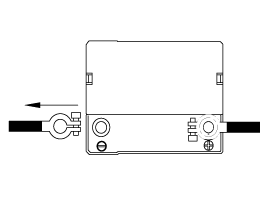 Kia Rio: AGM Battery: Cleaning
Kia Rio: AGM Battery: Cleaning
| 1. |
Make sure the ignition switch and all accessories are in the OFF
position.
|
| 2. |
Disconnect the battery cables (negative first).
|
| 3. |
Remove the battery from the vehicle.
|
| 4. |
Inspect the battery tray for damage caused by the loss of electrolyte.
If acid damage is present, it will be necessary to clean the area with
a solution of clean warm water and baking soda. Scrub the area with
a stiff brush and wipe off with a cloth moistened with baking soda and
water.
|
| 5. |
Clean the top of the battery with the same solution as described
above.
|
| 6. |
Inspect the battery case and cover for cracks. If cracks are present,
the battery must be replaced.
|
| 7. |
Clean the battery posts with a suitable battery post tool.
|
| 8. |
Clean the inside surface of the terminal clamps with a suitable
battery cleaning tool. Replace damaged or frayed cables and broken terminal
clamps.
|
| 9. |
Install the battery in the vehicle.
|
| 10. |
Connect the cable terminals to the battery post, making sure tops
of the terminals are flush with the tops of the posts.
|
| 11. |
Tighten the terminal nuts securely.
|
| 12. |
Coat all connections with light mineral grease after tightening.
|
 AGM Battery: Inspection
AGM Battery: Inspection
Battery Diagnostic Flow
Vehicle parasitic current inspection
1.
Turn all the electric devices OFF, and then turn the ignition
switch OFF.
...
 DC/DC Converter: Component Location
DC/DC Converter: Component Location
1. DC/DC Converter
...
See also:
Rain Sensor System Function
Basic Principle
Emitted Beam from luminosity diode is reflected entirely against the windshield
exterior, and then turn into photo diode.
If there is water on the windshield exterior, be ...
EBD(Electronic Brake-force Distribution) Operation
The Electronic Brake force Distribution (EBD) system as a sub-system of
the ABS system is to control the maximum braking effectiveness by the rear wheels.
It further utilizes the efficiency ...
Lift And Support Points
When heavy rear components such as suspension, fuel tank, spare
tire, tailgate and trunk lid are to be removed, pla ...
Copyright © www.kirmanual.com 2014-2025


